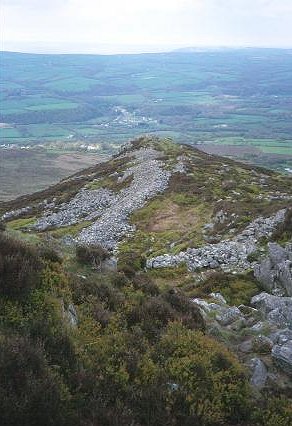Mynydd Carningli facts for kids
Quick facts for kids Mynydd Carningli |
|
|---|---|

Mynydd Carningli
|
|
| Highest point | |
| Elevation | 346 m (1,135 ft) |
| Prominence | 232 m (761 ft) |
| Parent peak | Foel Cwmcerwyn |
| Listing | Marilyn |
| Naming | |
| English translation | Angel–rock mountain |
| Language of name | Welsh |
| Geography | |
| Location | Pembrokeshire, Wales |
| Parent range | Preseli Hills |
| OS grid | SN062371 |
| Topo map | OS Landranger 145 |
| Geology | |
| Last eruption | 450 million years ago |
Mynydd Carningli is a special mountain in the Preseli Hills of Wales. It's close to the town of Newport, Pembrokeshire. This mountain is important because it has many old remains from long, long ago.
Contents
Exploring Carningli's Landscape
Carningli, sometimes called Carn Ingli, stands about 347 meters (1,138 feet) high. It's very close to the coast and really stands out in the area. It's not too hard to climb, but the top is rocky. There's also a steep slope of loose rocks on its south and east sides. The mountain is also a SSSI, which means it's a protected area because of its important plants and animals.
Uncovering the Carningli Hillfort
The very top of Carningli has a huge and amazing ancient site. It's one of the biggest hillforts in west Wales. A hillfort is like an ancient fortified village built on a hill for protection.
A Look at the Hillfort's History
This hillfort was likely built during the Iron Age, which was about 2,000 to 3,000 years ago. It covers a large area, about the size of four football fields. Some parts of the hillfort might even be older, from the Bronze Age.
What the Hillfort Looks Like
The hillfort is very complex. It has strong stone walls and banks, along with natural rock cliffs and rocky slopes that helped protect it. Inside and outside these walls, you can see flat areas, round hut circles (where people lived), and rectangular shapes. There are about 25 hut circles at one end of the site. On the other side, there are three separate areas with their own protective banks.
Who Lived Here?
People who lived in hillforts like Carningli probably raised animals like sheep and cattle. Because the mountain is very open and windy, it's possible that people only lived there during certain times of the year, perhaps moving their animals to higher ground in warmer months.
The Mountain's Sacred Stories
According to old legends, a local Saint named Brynach used to climb to the top of Carningli in the 5th century. He went there to find peace, pray, and "talk with the angels." This is why some old maps and writings call the mountain Carn Yengly or Carnengli. These names probably come from "Carn Engylau," which means "the rocky summit of the angels." However, not everyone agrees on this exact meaning of the name.
Carningli in Books
The mountain is also famous in books! Author Brian John wrote a series of eight books called the "Angel Mountain Saga." These stories are about a character named Mistress Martha Morgan of Plas Ingli. In the books, Carningli mountain is a special, peaceful place for her.
Carningli's Old Industry
Long ago, there was a small "mountain railway" on Carningli. It was used to carry broken stones from a small quarry down to a crushing plant. You can still find some old railway sleepers (the wooden blocks under the tracks) in the grass. The only other things left are two stone pillars that held a cable drum. This cable helped control the wagons as they rolled downhill and pulled the empty ones back up. This small industry stopped working before 1930.


